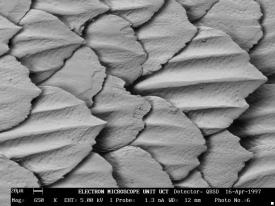Biomimicry
Biomimicry is a approach to design that mimics specific systems or processes found in nature. It has been around a lot longer than 3D printing. The collage depicts several innovative designs that are directly based on certain properties found in nature.
Sharkskin
For example, Speedo’s Sharkskin swimsuit uses a counter-intuitive approach to reducing drag with a rougher surface that slightly increases turbulence. It’s modeled on the denticles on the surface of a shark’s skin that allow for faster movement than a completely smooth surface. The dimples on a golf ball have similar effect.
The slide show, 7 amazing examples of biomimicry, goes through them in better detail.
Also see the slide show titled “14 Smart Inventions Inspired by Nature: Biomimicry”.
Shinkasen Bullet Train
The Shinkansen Bullet Train is another great example of basing designs off things found in nature. One of the problems with the Shinkansen train was the great loud noise that was created by the friction between the air and the train’s body.

“Eiji Nakatsu, an engineer with JR West and a birdwatcher, used his knowledge of the splashless water entry of kingfishers and silent flight of owls to decrease the sound generated by the trains.”
Excerpt from “Shinkansen Train” on Ask Nature
Kingfishers move quickly from air, a low-resistance (low drag) medium, to water, a high-resistance (high drag) medium. The kingfisher’s beak provides an almost ideal shape for such an impact. The beak is streamlined, steadily increasing in diameter from its tip to its head. This reduces the impact as the kingfisher essentially wedges its way into the water, allowing the water to flow past the beak rather than being pushed in front of it. Because the train faced the same challenge, moving from low drag open air to high drag air in the tunnel, Nakatsu designed the forefront of the Shinkansen train based on the beak of the kingfisher.
Excerpt from “Shinkansen Train” on Ask Nature
This image is taken from “The three-dimensional shape of serrations at barn owl wings: towards a typical natural serration as a role model for biomimetic applications” by Thomas Bachmann and Hermann Wagner, a great article that goes more in depth into the science behind the serrations on the feather.
Engineers were able to reduce the pantograph’s noise by adding structures to the main part of the pantograph to create many small vortices. This is similar to the way an owl’s primary feathers have serrations that create small vortices instead of one large one.”
Excerpt from “Shinkansen Train” on Ask Nature
The designers used what they observed in nature and applied it to the train to solve their problem.
Scott Sheppard‘s blog post, Eiji Nakatsu: Lecture on Biomimicry as applied to a Japanese Train,
Examples from Janine Benyus
Since writing her book, Biomimicry: Innovation Inspired by Nature, Janine Benyus has become a major figure in the Biomimicry movement by also co-founding the Biomimicry 3.8 and the Biomimicry Institute. Janine Benyus shares a lot of her thoughts and predictions in her one of a few TED Talk which is a great talk if you haven’t seen it already.
There are clearly a lot examples, past and present, of things that got their inspirations from nature. It has been talked about a lot in regards to 3D printing because 3D printing offers a very high level of customization during the build process. There are already 3D printed objects based on nature:
- Janne Kyttanen’s sofa,
- spider webs with carbon fiber,
- fish scales,
- bionic handling assistant,
- natural bone,
and many more.
“Biomimicry is a combination of science, technology, mathematics, and engineering which looks to nature as a teacher to solve modern human design challenges. 3D printing is rapidly changing the way the world interacts with building and making products, and Biomimicry offers a new perspective on this technology.”
Karen McDonald in Biomimicry and 3D Printing
Biomimicry will continue to influence modern 3D printing design principles; not because it is something new, but an approach that has been already applied to many fields.
Related Posts
- 3D Printing Tradeoffs and Optimization
- 3D Printing Evolution Functional Block Diagram
- The Next Best Thing But Not Yet
- 3D Printer Combinations
- 3D Scanners-Current Limitations
- 3d Printing IP Issues
About the Author
Max Murphy is Mechanical Engineering student in his Junior year at California Baptist University. He is interested in the implications of 3D printing or positive manufacturing for mechanical design. In the summer he is was an intern with Soundfit, one of the companies that is part of the Bay Area Advanced Manufacturing Hub (BAAM), where he is gained hands on experience with a 3D printer and scanner. He was also an intern with Neodyne Biosciences working with the R&D and Q&A departments.




One thought on “Biomimicry With 3D Printing of Shapes and Surfaces”